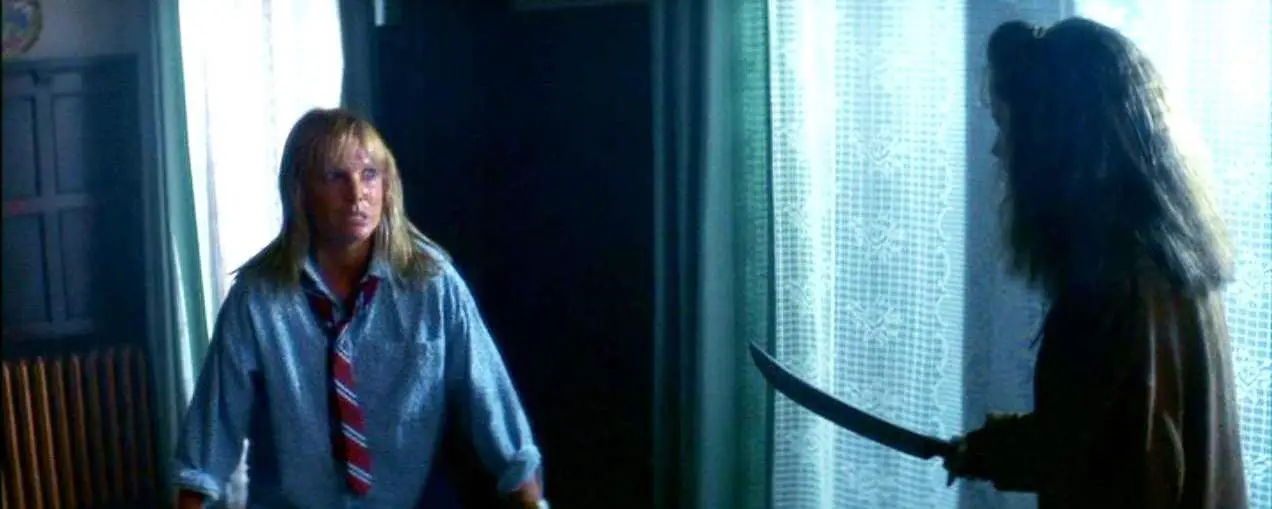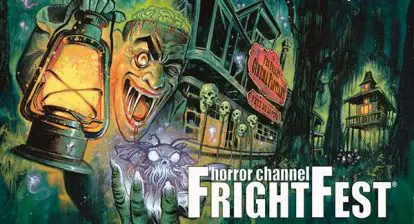The 1980s is generally considered to be the golden age of slasher movies. Following the success of John Carpenter’s seminal classic Halloween (released in 1978), studios tried to capitalise on moviegoers assumed new appetite for blood-soaked, holiday (or even just special day) themed fare. And thus, Friday The 13th, My Bloody Valentine, Prom Night et al. were released upon the world, to spawn numerous sequels and copycats for years to come. We’re still feeling the shock-waves today, with the likes of The Babadook, The Guest and It Follows all paying homage to this period.
Curiously, one of the strongest additions to this weirdly-themed set doesn’t receive nearly as much recognition as its compatriots. Although it’s gained a cult following, thanks to the lucrative home video market, it’s rarely any genre fan’s first choice. This is partly due to the fact that April Fool’s Day, released in 1986, could arguably be considered a black comedy, particularly in comparison to the blood-soaked likes of Friday The 13th.
The lack of any real body count (considering the deaths are all part of an elaborate April Fool’s Day prank at the hand of the film’s protagonist, a rich girl hilariously named Muffy), and indeed flimsy connections to the Paramount Pictures adaptation of the popular board-game, Clue, which came out in 1985, doesn’t really help. However, regardless of the fact that none of the grisly murders turn out to be real, and it’s sort of a non-murder mystery at its core as a result, April Fool’s Day is still an accomplished slasher movie in its own right, not to mention smarter and braver than it has any right to be.
The flick follows eight college friends, all of whom are well-drawn and assuredly-acted by a game young cast, who are spending a weekend together at the island estate of their rich friend. Right off that bat, there are gruesome April Fool’s jokes galore, including a stabbing incident on the boat ride over. All of the usual harbingers of doom are present and accounted for–from the creepy ferry captain to the confirmation that no one will be around to help until Monday, to a cutesy music box, out of which a scary monster pops–and all of which is blatant foreshadowing for what’s to come.Refreshingly, events don’t follow the same course to which we’ve become accustomed. The unsuspecting houseguests soon learn that everything is booby-trapped, from the taps to the doorknobs, but it’s all very light-hearted until someone goes missing, and even then it takes a while for the darkness to really hit. The killer isn’t hinted at from the outset, and only his/her feet are shown when he/she does appear. Murders take place both in daylight and at dusk, and the violence is hinted at rather than shown. Blood is spilled, but it’s the bright-red, Suspiria kind and the creepiest instance of it involves a collection of Barbie dolls. The gore is minimal, the atmosphere is effectively created by a beautifully strange score by Charles Bernstein, who also scored A Nightmare On Elm Street.
April Fool’s Day stands leagues apart from its contemporaries because it plays nice. Slashers have a tendency to be a bit mean-spirited, and unnecessarily nasty (for more evidence of this, see the unofficial, 2008 DTV remake of the same name) but here the mystery is pieced together by the characters as the audience simultaneously tries to get their heads around it (what’s wrong with Muffy? Is she acting weird because it’s actually her evil twin?). These kids aren’t just walking bags of bones either, they’re thoughtful and opinionated, each with their own struggles. The women aren’t damsels in distress, choosing more often than not to venture into the path of danger rather than hang back and wait for help. They behave rationally too, sticking together and calling the cops once they realise something is wrong.
 Courtesy of Fred Walton, who also helmed the terrifying When A Stranger Calls (which followed Halloween in 1979) it’s especially interesting that April Fool’s Day takes the road it does. Considering the fact it’s often dismissed as a horror-comedy (a patronising label, if ever there was one), it packs quite a lot of frights into its ninety minutes. A sequence in a well, in which a female character happens upon the severed heads and floating corpse of her friends, is nail-bitingly tense while another, which sees a water-logged body bob underneath an amorous couple is pulse-quickening if only because it comes out of absolutely nowhere.
Courtesy of Fred Walton, who also helmed the terrifying When A Stranger Calls (which followed Halloween in 1979) it’s especially interesting that April Fool’s Day takes the road it does. Considering the fact it’s often dismissed as a horror-comedy (a patronising label, if ever there was one), it packs quite a lot of frights into its ninety minutes. A sequence in a well, in which a female character happens upon the severed heads and floating corpse of her friends, is nail-bitingly tense while another, which sees a water-logged body bob underneath an amorous couple is pulse-quickening if only because it comes out of absolutely nowhere.
April Fool’s Day doesn’t follow the slasher handbook, which may go some way towards explaining why it often isn’t afforded the same respect as its contemporaries. It’s also way ahead of its time, with an opening sequence involving various characters doing to-camera pieces explaining who they are, as the jokey member of the group films everything. This is something that has become a given in horror movies, particularly in found footage, and yet it shows up in a film that was released in the eighties. Crucially, it makes sense, too, as the camera is soon dropped upon arrival at the island because, as we often ask ourselves, why wouldn’t it be?
Whether or not you think the ending is a bit hokey–it’s quite an elaborate setup, after all–the idea of the house in question being turned into a whodunnit-style country manor is genius. It’s the perfect setting for this kind of madness; expansive, almost maze-like and in the middle of nowhere. This movie is such good fun, and it’s aged really well considering it’ll be celebrating its thirtieth birthday next year. Much like My Bloody Valentine on Valentine’s Day, or Halloween on Halloween, there really is only one option for April Fool’s Day and it’s April Fool’s Day.








